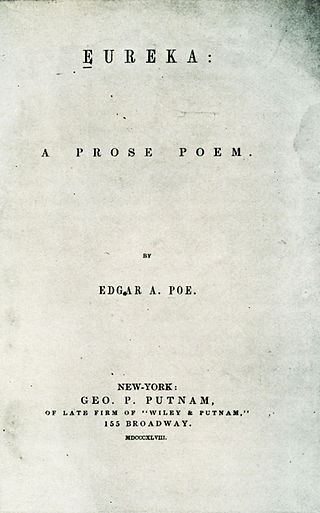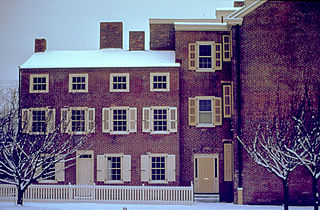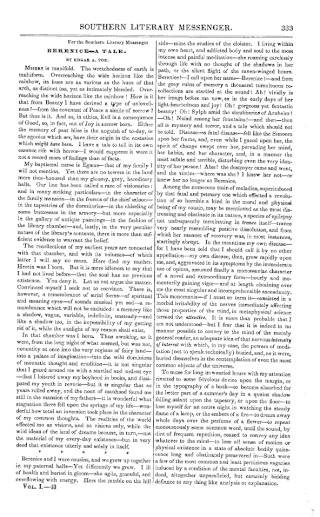
"Eulalie", or "Eulalie — A Song", is a poem by Edgar Allan Poe, first published in the July 1845 issue of The American Review and reprinted shortly thereafter in the August 9, 1845 issue of the Broadway Journal .

"Eulalie", or "Eulalie — A Song", is a poem by Edgar Allan Poe, first published in the July 1845 issue of The American Review and reprinted shortly thereafter in the August 9, 1845 issue of the Broadway Journal .
The poem is a bridal song about a man who overcomes his sadness by marrying the beautiful Eulalie. [1] The woman's love here has a transformative effect on the narrator, taking him from a "world of moan" to one of happiness. [2]
The poem uses Poe's frequent theme of "the death of a beautiful woman," which he considered to be "the most poetical topic in the world." [3] The use of this theme has often been suggested to be autobiographical by Poe critics and biographers, stemming from the repeated loss of women throughout Poe's life, including his mother Eliza Poe and his foster mother Frances Allan. [4] If autobiographical, "Eulalie" may be referring to Poe's relationship with his wife Virginia. It seems to express that she lifted his spirits and washed away his feelings of loneliness. After Virginia's death in 1847, Poe scribbled on a manuscript copy of "Eulalie" a couplet, now known as "Deep in Earth". [5] It is unclear if Poe intended this to be part of "Eulalie", an unfinished new poem, or just a personal note.
The name Eulalie emphasizes the letter "L", a frequent device in Poe's female characters such as "Annabel Lee", "Lenore", and "Ulalume". [6]

The poem was first published as "Eulalie — A Song" in the July 1845 issue of the American Review — it was the only new poem Poe published that year, [7] other than "The Raven".

Edgar Allan Poe was an American writer, poet, author, editor, and literary critic who is best known for his poetry and short stories, particularly his tales of mystery and the macabre. He is widely regarded as a central figure of Romanticism and Gothic fiction in the United States, and of American literature. Poe was one of the country's earliest practitioners of the short story, and is considered the inventor of the detective fiction genre, as well as a significant contributor to the emerging genre of science fiction. He is the first well-known American writer to earn a living through writing alone, resulting in a financially difficult life and career.

"The Balloon-Hoax" is the title used in collections and anthologies of a newspaper article by American writer Edgar Allan Poe, first published in 1844 in The Sun newspaper in New York. Originally presented as a true story, it detailed European Monck Mason's trip across the Atlantic Ocean in only three days in a gas balloon. It was later revealed as a hoax and the story was retracted two days later.

"The Raven" is a narrative poem by American writer Edgar Allan Poe. First published in January 1845, the poem is often noted for its musicality, stylized language, and supernatural atmosphere. It tells of a distraught lover who is paid a mysterious visit by a talking raven. The lover, often identified as a student, is lamenting the loss of his love, Lenore. Sitting on a bust of Pallas, the raven seems to further antagonize the protagonist with its constant repetition of the word "Nevermore". The poem makes use of folk, mythological, religious, and classical references.

"Annabel Lee" is the last complete poem composed by American author Edgar Allan Poe. Like many of Poe's poems, it explores the theme of the death of a beautiful woman. The narrator, who fell in love with Annabel Lee when they were young, has a love for her so strong that even angels are envious. He retains his love for her after her death. There has been debate over who, if anyone, was the inspiration for "Annabel Lee". Though many women have been suggested, Poe's wife Virginia Eliza Clemm Poe is one of the more credible candidates. Written in 1849, it was not published until shortly after Poe's death that same year.

Eliza Poe was an English actress and the mother of the American author Edgar Allan Poe.

"Lenore" is a poem by the American author Edgar Allan Poe. It began as a different poem, "A Paean", and was not published as "Lenore" until 1843.

"Ulalume" is a poem written by Edgar Allan Poe in 1847. Much like a few of Poe's other poems, "Ulalume" focuses on the narrator's loss of his beloved due to her death. Poe originally wrote the poem as an elocution piece and, as such, the poem is known for its focus on sound. Additionally, it makes many allusions, especially to mythology, and the identity of Ulalume herself, if a real person, has been a subject of debate.

"The City in the Sea" is a poem by Edgar Allan Poe. The final version was published in 1845, but an earlier version was published as "The Doomed City" in 1831 and, later, as "The City of Sin". The poem tells the story of a city ruled by a personification of Death using common elements from Gothic fiction. The poem appeared in the Southern Literary Messenger, The American Review, the Broadway Journal, as well as in the 1850 collection The Poets and Poetry of America.

"The Philosophy of Composition" is an 1846 essay written by American writer Edgar Allan Poe that elucidates a theory about how good writers write when they write well. He concludes that length, "unity of effect" and a logical method are important considerations for good writing. He also makes the assertion that "the death... of a beautiful woman" is "unquestionably the most poetical topic in the world". Poe uses the composition of his own poem "The Raven" as an example. The essay first appeared in the April 1846 issue of Graham's Magazine. It is uncertain if it is an authentic portrayal of Poe's own method.

Eureka (1848) is a lengthy non-fiction work by American author Edgar Allan Poe (1809–1849) which he subtitled "A Prose Poem", though it has also been subtitled "An Essay on the Material and Spiritual Universe". Adapted from a lecture he had presented, Eureka describes Poe's intuitive conception of the nature of the universe, with no antecedent scientific work done to reach his conclusions. He also discusses man's relationship with God, whom he compares to an author. Eureka is dedicated to the German naturalist and explorer Alexander von Humboldt (1769–1859).

The Edgar Allan Poe National Historic Site is a preserved home once rented by American author Edgar Allan Poe, located at 532 N. 7th Street, in the Spring Garden neighborhood of Philadelphia, Pennsylvania. Though Poe lived in many houses over several years in Philadelphia, it is the only one which still survives. It was designated a National Historic Landmark in 1962.

"Berenice" is a short horror story by American writer Edgar Allan Poe, first published in the Southern Literary Messenger in 1835. The story is narrated by Egaeus, who is preparing to marry his cousin Berenice. He tends to fall into periods of intense focus, during which he seems to separate himself from the outside world. Berenice begins to deteriorate from an unnamed disease until only her teeth remain healthy. Egaeus obsesses over them. When Berenice is buried, he continues to contemplate her teeth. One day, he awakens with an uneasy feeling from a trance-like state and hears screams. A servant reports that Berenice's grave has been disturbed, and she is still alive. Beside Egaeus is a shovel, a poem about "visiting the grave of my beloved", and a box containing 32 teeth.

"Eleonora" is a short story by American writer Edgar Allan Poe, first published in 1842 in Philadelphia in the literary annual The Gift. It is often regarded as somewhat autobiographical and has a relatively "happy" ending.
This article lists all known poems by American author and critic Edgar Allan Poe, listed alphabetically with the date of their authorship in parentheses.

Tamerlane and Other Poems is the first published work by American writer Edgar Allan Poe. The short collection of poems was first published in 1827. Today, it is believed only 12 copies of the collection still exist.

The American Review, alternatively known as The American Review: A Whig Journal and The American Whig Review, was a New York City-based monthly periodical that published from 1844 to 1852. Published by Wiley and Putnam, it was edited by George H. Colton, and after his death, beginning with Volume 7, by James Davenport Whelpley. As of Volume 10, July 1849, the proprietors of the journal were Whelpley and John Priestly.

"Never Bet the Devil Your Head: A Moral Tale" is a short story by American author Edgar Allan Poe, first published in 1841. The satirical tale pokes fun at the notion that all literature should have a moral and spoofs transcendentalism.

"Thou Art the Man", originally titled "Thou Art the Man!", is a short story by Edgar Allan Poe, first published in 1844. It is an early experiment in detective fiction, like Poe's "The Murders in the Rue Morgue", though it is generally considered an inferior story.
William Henry Leonard Poe, often referred to as Henry Poe, was an American sailor, amateur poet and the older brother of Edgar Allan Poe and Rosalie Poe.

The works of American author Edgar Allan Poe include many poems, short stories, and one novel. His fiction spans multiple genres, including horror fiction, adventure, science fiction, and detective fiction, a genre he is credited with inventing. These works are generally considered part of the Dark romanticism movement, a literary reaction to Transcendentalism. Poe's writing reflects his literary theories: he disagreed with didacticism and allegory. Meaning in literature, he said in his criticism, should be an undercurrent just beneath the surface; works whose meanings are too obvious cease to be art. Poe pursued originality in his works, and disliked proverbs. He often included elements of popular pseudosciences such as phrenology and physiognomy. His most recurring themes deal with questions of death, including its physical signs, the effects of decomposition, concerns of premature burial, the reanimation of the dead, and mourning. Though known as a masterly practitioner of Gothic fiction, Poe did not invent the genre; he was following a long-standing popular tradition.